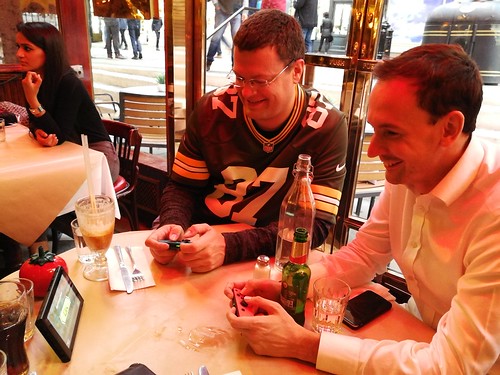It has been a while, but here is part two of my reflections on being a church treasurer. If you missed it,
here is part one. Last time was mostly about vision and strategy. This is about people.
Back to the things I learned and experienced.
Lesson 5: It's dangerous to go alone...
Time is finite. An Earth-shattering discovery. However, the important point here is about setting expectations - both in others in yourself. This kind of role can easily be a full-time job, and this is one of the reasons it's often picked up by a retired person. Limiting factors like Having a Job and Wanting a Life will severely cut into the amount of time available and hence what can be delivered. It took me a long time to get this straight in my head and stop beating myself up for how long everything seemed to take - especially since business as usual work ate up a significant amount of the time I could otherwise have used for improving things.
It's impossible to create more time, so if you want to get more done you need other people to help. I set up a team to help and together we achieved things I had initially discarded as impossible for me alone. It astonished me that creating a Finance Team wasn't standard - I had several conversations with members of other churches who took this revolutionary thinking back with them. Another lesson for me was that just because something seemed obvious, that didn't mean it is. It is worth sharing your thinking.
Lesson 6: ... but choose your companions wisely
Forming a team in a charity is an art in itself. The obvious approach is to simply ask for volunteers, however if you do that you'll find you get the same faces who appear over and over in other teams. These people are going to be busy already, and are the people pre-disposed to volunteering - not necessarily the folk with the most useful skills.
Volunteers are nothing like paid staff. Our motivation is based on enthusiasm for the cause of the charity, supporting each other and our interest in the task at hand and it is all too easy to destroy any or all of these if the group isn't pulling in the same way. In my case, I was forming a group which was to act under my authority as a treasurer so I needed people I could trust to behave with integrity and who I could ask to do things and believe they would actually do them.
I avoided asking for volunteers. I think it misses the opportunity to encourage folk who wouldn't normally put themselves forward and it makes it very likely the resulting team will struggle to gel. Instead, after consulting as many people as I could looking for likely victims, I approached a handful of people who I thought would have the right combination of skills and perspectives. Most were people who did little to no volunteering in the church. I was fortunate that all but one agreed to join my merry band and they did so with the confidence that The Leader (me, gosh) believed in them.
There are definitely pitfalls to be avoided. Exclusively approaching people relies on your own knowledge of the people available, and triggers all of your biases, conscious or unconscious. There is a balance to be struck but it's too easy to just ask for volunteers and miss an opportunity to encourage people who otherwise wouldn't put themselves forward.
Lesson 7: A shared vision brings a team together
Next, I needed to turn the group into a team. Providing a constant stream of brightly-coloured cake definitely helped.
We had several sessions discussing the direction of finance in St Swithin's and prioritising out work. I outlined the problems as I saw them and let the conversation take its course and by the end we all owned the resulting plan. This bound the team together as the strategy came from the team, not from me. Not only did this do wonders for the motivation, we also ended up with a more ambitious programme than I had originally had in mind. When discussing the problems, we collectively decided that we couldn't do anything without a new computer system - something I had previously discarded as I didn't have time to do it. However, others in the group saw it was the most important thing we could do and volunteered to take it on.
Lesson 8: Learn to predict the future (and convince others of your mystic powers)
Accurate crystal balls are hard to come by, but there are ways to peer into the future with some accuracy. Looking at trends in income / expenditure give a clear indication as to what is going to happen - if the budget is any good it's quite easy to start thinking about what happens next year and the year after.
By asking ourselves several "what if" questions we got a picture of the problems hidden in the heart of our finance. Some were real (trends which predicted issues further down the line) and some were potential ("what if the top three donors all moved away this year?") and they let us set policies which helped mitigate these risks. For instance, following an analysis of the profile of our donations we diversified our income and changed the way we solicited giving.
In theory, spotting difficulties ahead of time should have let us do something about them before they became major problems. The hard part is convincing other people in the organisation when there are problems ahead. I presented year on year on the challenges hiding in the heart of our budget, however those problems were not immediate and so generating the right response (immediate action without panic) was extremely difficult. This is partly the nature of this role - as noted before, the ingrained culture was that finance was my problem so solving these problems was also my problem.
Regardless of the difficulties, all this helped me learn the value of investing the time in using the data available to make predictions, not just validate (or otherwise) the decisions of the past. Obvious, maybe, but this was the experience that cemented it in my mind. In the business of day to day life it's easy to forget it and drift further and further into being just reactive.
Lesson 9: Volunteers are not staff
I've already mentioned this above, but it's something to pick up on again. I was a volunteer in a professional organisation (the Church of England). There were things I had to do, legally, to perform my role. There was also an awful lot that I didn't have to do, but was very helpful to the wider organisation. As noted before, time is finite and whether I did any of these things depended on my motivation to spend that time assisting the wider organisation rather than (or in addition to) working to improve my local church.
Motivation is a tricky beast. With a volunteer, it's the only thing that is making them keep giving their time to you and not someone else. It is very easy for a large organisation to forget when it is relying on the goodwill of volunteers over whom they have very little actual control. However, if this does happen it doesn't take long for all those extra voluntary jobs to stop happening.
The short version is - if you're in a paid position, remember when you're dealing with volunteers or you will lose them. They owe you nothing.
Lesson 10: The importance of process
Volunteer groups are often held together by the links between people. Indeed, professional organisations usually have back-channels for getting things done because person X is friends with person Y in another team, which means they hear about stuff that is going on over there.
This is natural, and inevitable unless we want a world where we behave like automatons fitted to a job description. However, there needs to be a plan in place for the people who come next.
When I took on my role as a treasurer, it was on the back of all the previous finance people stepping down. I inherited very little, and while the former volunteers were very helpful it still meant I had to re-solve a lot of problems. Had there been clear processes in place I could have slipped into the role far more easily.
I'm cheating a little here as this was actually a lesson I learned back during my time as part of the team running a student radio station. Back then we worked very hard to ensure there was no clique (encouraging new people to join) and we had established processes (allowing others to keep the station going when we were gone). During my time as a treasurer, we brought in all kinds of new practices and we always did our best to make sure they didn't rely on the specific people in post. We documented, handed over knowledge as best we could and generally tried to make sure the next lot would have a far easier time.
I hope my successor has inherited a working system and is getting as much from the role as I did.











